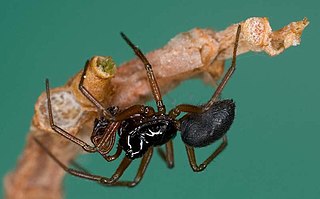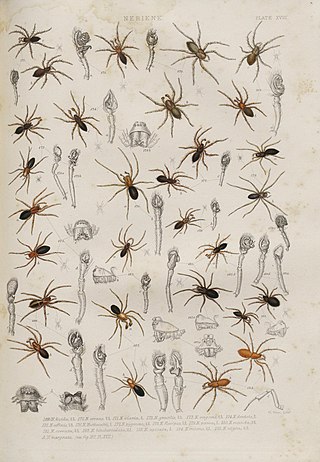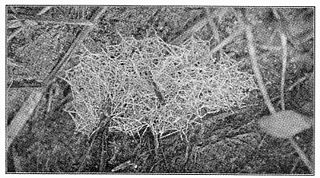Erigone (Ἠριγόνη) may refer to:

Erigoninae are the largest subfamily of sheet weavers (Linyphiidae), which is itself the second largest spider family. In the United States they are known as dwarf spiders, while they are called money spiders in England. The exact taxonomic limits of the subfamily are not yet known.

Nartheciaceae is a family of flowering plants. The APG III system places it in the order Dioscoreales, in the clade monocots. As circumscribed by APG IV (2016) it includes 35 species of herbaceous plants in the following five genera:

163 Erigone is an asteroid from the asteroid belt and the namesake of the Erigone family of asteroids that share similar orbital elements and properties. It was discovered by French astronomer Henri Joseph Perrotin on April 26, 1876, and named after one of the two Erigones in Greek mythology. This asteroid is orbiting the Sun at a distance of 2.37 AU with a period of 3.643 years and an eccentricity (ovalness) of 0.19. The orbital plane is inclined at an angle of 4.8° to the plane of the ecliptic.

Aletris, the colicroot, colicweed, crow corn, or unicorn root, is a genus of flowering plants in the family Nartheciaceae, native to North America and to eastern and southeastern Asia, especially China. It was used as a component in Lydia Pinkham's original Vegetable Compound.

Erigone is a genus of dwarf spiders that was first described by Jean Victoire Audouin in 1826. They are carnivorous, preying on small insects such as Psylla and flies. One of the distinctive characters for this genus is the presence of teeth bordering the carapace.

Aletris farinosa, called the unicorn root, true unicorn, crow-corn, white colic-root or white stargrass, is a plant species found across much of the eastern United States. It has also been reported from the southern part of Ontario, Canada. It is known from every state east of the Mississippi River except Vermont, as well as Texas, Oklahoma, Arkansas and Louisiana. Its native habitats include moist peaty, sandy or gravelly areas.

Trematocephalus is a genus of sheet weavers first described by Friedrich Dahl in 1886.

Hypomma is a genus of dwarf spiders that was first described by David B. Hirst in 1886.

Moebelia is a genus of dwarf spiders that was first described by Friedrich Dahl in 1886.
Silometopus elegans is a species of spiders in the family Linyphiidae found in Europe. It was first described by Octavius Pickard-Cambridge in 1873, as Erigone elegans. It was transferred to the genus Silometopus by Eugène Simon in 1884.
Erigone autumnalis is a species of dwarf spiders in the family Linyphiidae. It is found in North and Central America, and it has been introduced to Azores, Europe, United Arab Emirates, and New Caledonia.
Erigone blaesa is a species of dwarf spider in the family Linyphiidae. It is found in the USA and Canada.

Erigone atra is a species of dwarf spider or money spider, in the family Linyphiidae. It is commonly found in North America, Europe, parts of Russia, Central Asia, China, Mongolia, Korea, and Japan. This spider is one of the most common Erigone spiders. E. atra is an important spider for agriculture, as it preys on pests such as aphids which are commonly found on crops. E. atra spiders are aeronautical spiders, as they travel via ballooning. This technique, sometimes referred to as kiting, allows E. atra spiders to traverse large distances and find new habitats when environmental or human stresses create unfit living environments. E. atra is difficult to differentiate from other congeneric species because of their similar sizes and coloring.
Erigone dentosa is a species of dwarf spider in the family Linyphiidae. It is found in a range from the United States to Guatemala and has been introduced into Belgium.

Erigone dentigera is a species of dwarf spider in the family Linyphiidae. It is found in North America, Europe, Caucasus, and Russia.
Vietnagone is a small genus of Asian sheet weavers native to southeastern Tibet and northern Vietnam. It was erected by A. V. Tanasevitch in 2019 for one newly described species and one transferred from Gongylidium. They are relatively small spiders, ranging from 1.5 to 1.78 millimetres long. The name is a combination of "Vietnam" and the genus Erigone, and as of April 2022 it contains only two species: V. rugulosa and V. silvatica.








